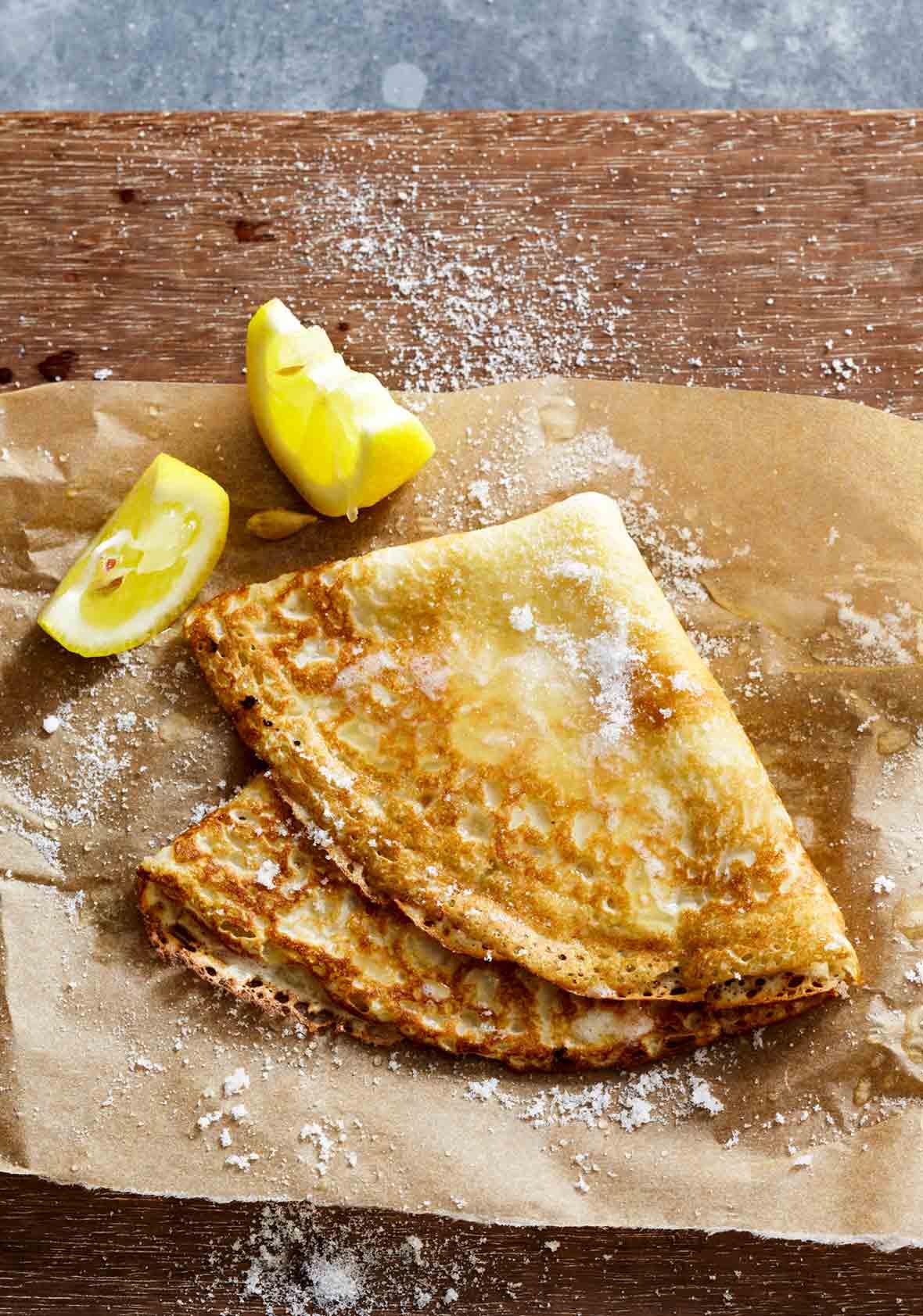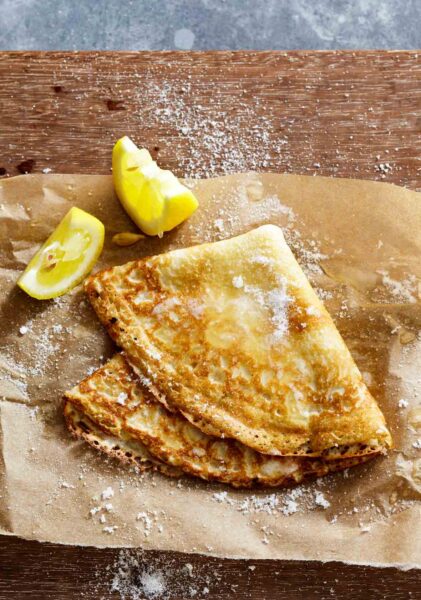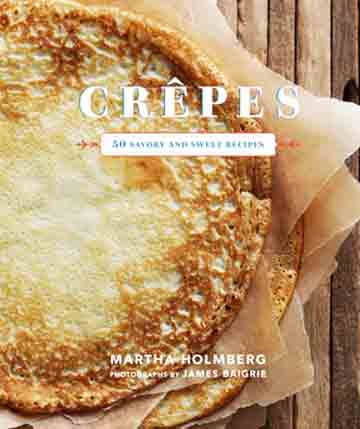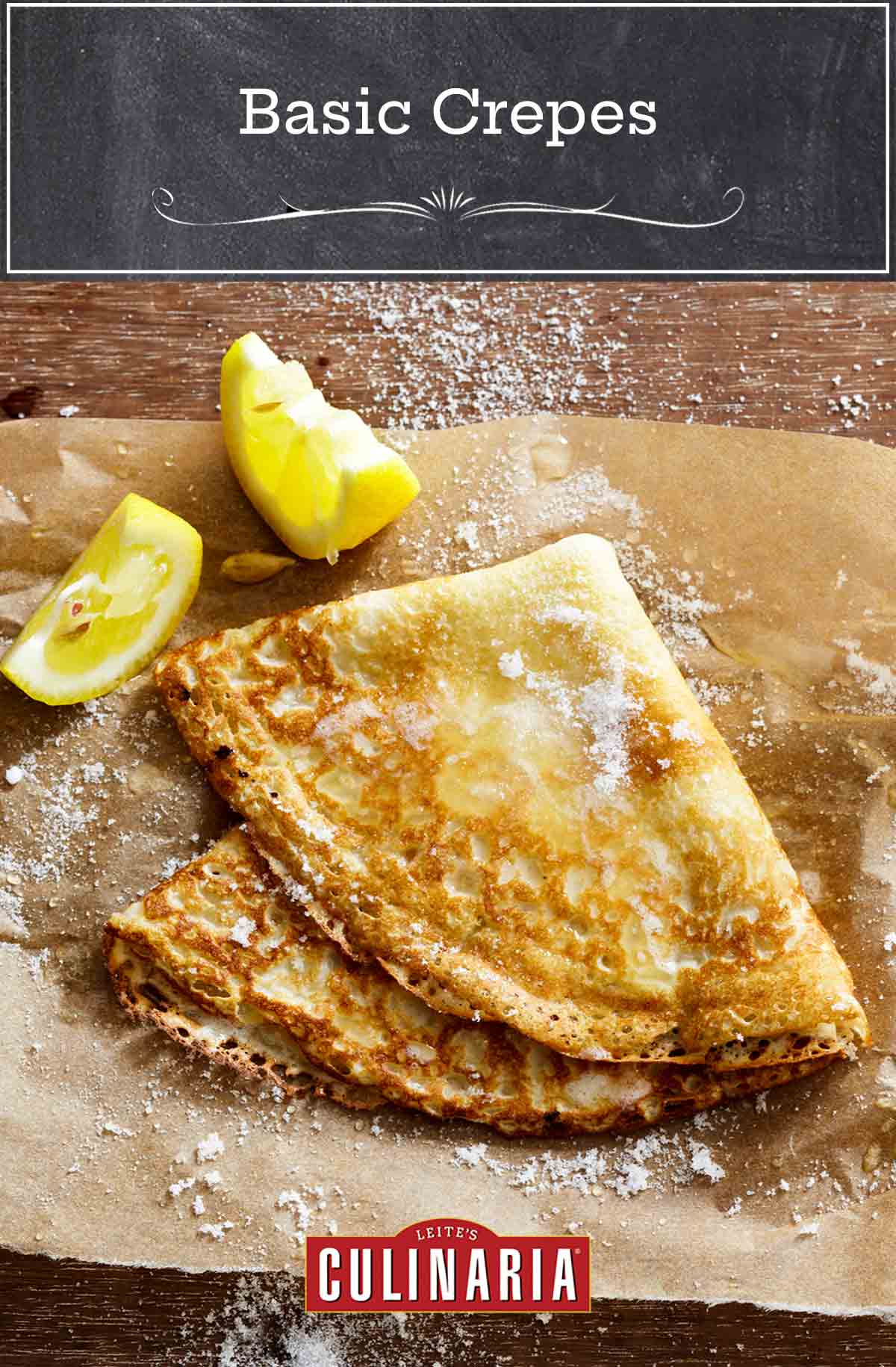
This deceptively named basic crepes recipe works for any crepe incarnation, savory and sweet, including blintz and turns out something that tastes anything but basic.–David Leite
Basic Crepes FAQs
Resting the batter is a crucial part of making crepes. By resting the batter, you allow the flour to bloom, which means to absorb the liquid fully. It also gives the gluten a chance to relax, so no rubbery crepes.
Your batter should be smooth with no lumps and have the consistency of heavy cream.
For a lighter crepe batter, substitute a few tablespoons of club soda for a few tablespoons of the milk.
A classic crepe pan is specially designed to turn out perfect-sized crepes. Also, its low flared sides make flipping crêpes a cinch. And the thin bottom heats quickly and evenly and when properly seasoned is the ideal nonstick surface. Don’t feel like buying another pan? An 8-to-10-inch nonstick skillet with rounded or flared sides will work well. David owns one and loves it.
Yes, you can. After making the crepes, just stack them neatly. Slide the crepe stack into a large resealable plastic bag and toss them in the fridge. The crepes will keep like this for up to 3 days. Let the stack sit at room temperature until the crepes are pliable, about an hour, and then peel them apart and proceed with your recipe.
To stash the crepes in the freezer, place pieces of waxed or parchment paper between the crepes so they don’t stick to one another. Then wrap the stack in plastic wrap, slide it into a large resealable freezer bag, and keep them in the freezer for 2 to 3 months. Let the stack sit at room temperature until the crepes are pliable, about an hour, and then peel them apart and proceed with your recipe.

Basic Crepes
Ingredients
- 1 3/4 to 2 1/4 cups whole milk
- 4 large eggs
- 1/2 teaspoon kosher salt
- 1 1/2 cups all-purpose flour
- 6 tablespoons unsalted butter, melted, plus more for the pan
Instructions
- Place 1 3/4 cups milk, eggs, and salt into a blender. Whiz for a few seconds to blend everything together. Remove the lid, add the flour, cover, and blend again until very smooth, about 20 seconds. Remove the lid, pour in the melted butter, cover, and whiz until combined, about 10 seconds more. (Alternately, you can simply whisk everything together.)
- Pour the batter into a large glass measuring cup with a spout or a bowl that’s large enough to easily fit a 1/4-cup measuring cup. Let the batter rest for at least 5 minutes and up to 24 hours. (If resting for more than 30 minutes, cover and stash the batter in the fridge.)
- When you’re ready to make crepes, test the batter’s consistency; it should be as thick as heavy cream but not as thick as pancake batter. If it feels too thick, whisk in a little more milk at a time, using up to a 1/2 cup more.
- Heat an 8-inch crepe pan or nonstick skillet over medium-high heat until it’s hot enough to make a drop of water sizzle upon contact. Using a folded paper towel, spread about 1/2 teaspoon butter around the interior of the pan. You want the pan to be sufficiently hot so that the butter sizzles upon contact, but not so hot that it instantly burns and turns brown.
- Pour about 1/4 cup crepe batter into the center of the pan and at the same time (or very shortly thereafter) lift the pan from the heat, tilting and turning it in all directions so the batter spreads evenly across the bottom of the pan into a thin circle.
☞ TESTER TIP: If there's a “tail” that’s left behind in the pan, no worries, you can trim that later.
- Cook the crepe until the edges begin to dry and lift from the sides of the pan and the bottom is nicely browned, about 1 minute. (To check for color, use a table knife, slim off-set spatula, or your fingers to lift up an edge of the crepe and peek underneath.)
- When the first side is ready, use the knife, spatula, or your fingers to lift the crepe and quickly flip it over. Smooth out any folded edges or pleats and then cook until the center is firm and the second side is browned, about 20 seconds more. The first side is almost always much prettier and more evenly browned (we’ll call it the presentation side), while the second side tends to be more spotty.
- Slide the crepe from the pan onto a large plate or cooling rack. Repeat with the remaining batter, adjusting the heat and wiping the pan with more butter as you cook. You can stack the crepes on the plate as they’re done.
☞ TESTER TIP: If you’re new to crepe-making, prepare to mess up the first crêpe (or even more) as you get the hang of swirling the batter into the pan, having your pan at the right temperature, and the timing.
- Serve the crepes individually, in short stacks or, if desired, fold the crepes in half to create half-moon shapes or fold again into quarters. If you're in a sweet mood, sprinkle them with powdered sugar or dollop with whipped cream. If you prefer savory crepes, fill them with ham and cheese, which is always a favorite.
Notes
Crêpes Variation
Brown Butter Crepes For most recipes, I not only melt the butter, but I cook it until the water has boiled off and the milk solids are starting to turn golden and take on a toasty flavor. At this stage, it’s called beurre noisette in French (“hazelnut butter”) or brown butter in English. It’s such a clever way to add a depth of flavor to the crepes. Simply substitute brown butter for the butter, tablespoon for tablespoon, in the ingredient list above. To make brown butter, melt 7 tablespoons unsalted butter in a small saucepan or skillet over medium heat. Cook the butter, swirling the pan every few seconds, until all of the water from the butter has sizzled off and the milk solids at the bottom of the pan begin to turn a pale golden color, 2 to 4 minutes. Continue cooking the butter until it turns golden brown and smells nutty and delicious, another few seconds. Immediately pour the brown butter into a bowl to stop the cooking. Let it cool to room temperature before using. When you add the butter to your basic crepes recipe, be sure to include the delicious toasty brown milk solids. Lemon, Sugar, and Butter Crepes Heat a small skillet over medium heat. Lay the crepe, presentation-side up, in the skillet and let it heat through for about 15 seconds. Flip it over, and using a rubber spatula or the bottom of a spoon, spread it with 1 teaspoon unsalted butter, at room temperature. Sprinkle the butter with 1/4 teaspoon granulated or confectioners’ sugar (or more to taste), then fold the crepe into a half-moon shape and sprinkle again with sugar, and squeeze a little lemon juice over the top. Then fold once more into a triangle. Sprinkle with more sugar if desired. Slide the crepe onto a plate and eat it right away. (Or, if you’re the lazy sort, just stack 2 or 3 crepes on a plate, each one buttered, sugared, and “lemon-ed.”) To boost the “dessertiness” of the crepes, add about 2 teaspoons sugar and 1 teaspoon vanilla extract to the batter.
Nutrition
Nutrition information is automatically calculated, so should only be used as an approximation.
Recipe Testers’ Reviews
Oh, there is just no messing with the classics! This is the perfect French crepe done in the very traditional French way. Having traveled extensively throughout France, I can tell you without a shadow of a doubt that this is the most delightful thing one can eat. Sweet, savory, lemony—all the taste sensations are touched with this little beauty.
Now I must confess to having cheated just a little on this one because I do actually have a crepe pan with very low sides which makes the flipping part ever so easy. No, really, it is easy! Just a little flip of the wrist and the crisp, giant “pancake” turns itself beautifully. And the recipe is very simple, in fact, it doesn’t get any easier than a blender, now does it?
I especially like the beurre noisette (brown butter) in this recipe—not completely traditional but a bonus nonetheless. And the lemon and sugar give the crepes that little pop along with the slight crunch sugar, if you use granular, which you really should. A lovely breakfast or a light lunch or after-school snack. Any time of day really is appropriate with this little beauty.
I followed the recipe exactly and it yielded the most delicate, buttery, and delicious crepes ever! These are so good! I’ve tried many a crepes recipe over the years, and this by far is my favorite. The ingredients come together so quickly.
But what I really liked about these crepes was how nicely they cooked and browned in the pan. I served some of the crepes with a squeeze of fresh lemon juice and powdered sugar, some with homemade nutella, and some plain. I can’t wait to make these again!
This is a VERY simple crepes recipe yet a very good idea. Butter, sugar, and lemon are each very nice on their own, but when you put them together, it’s nearly impossible to fail. If you already have the crepes prepared, anyone can make the variation, including an adolescent or a child, with supervision.
This is a very tasty recipe but if you wish to put them over the top, I suggest sprinkling some lemon zest over the crepes since you’ll already have a lemon at your disposal!
This is definitely a recipe I’d recommend to my friends. This crepes recipe is great as it’s simple and comes together quickly, and I of course followed the suggestion to use brown butter in place of regular melted butter. Fantastic. This just adds a nice depth of flavor to the crepes that complement both sweet and savory fillings.
I like the suggestion to add vanilla and sugar to the crepe batter if using it for dessert fillings, but I used the crepe recipe as-is for a sweet filling just to see how versatile it truly was. And I found the lemon, sugar, and butter crepes to be so simply satisfying! It’s a great classic combination, especially if you take the time to apply the sugar in layers as the recipe suggests.
I like to use a low enough heat so that the sugar can melt and caramelize as much as possible before the crepe itself becomes too crisp.
It doesn’t take too long to get the hang of making basic crepes, so I think everyone should give it a try! They freeze well, so make up a big batch of these. Have a crepe party, and play around with the fillings (just don’t forget the obligatory lemon, sugar, and butter version!)
I really enjoyed these versatile basic crepes—they’ll definitely be my go-to crepes from now on. Such an elegant snack, dessert, or even breakfast (that’s how we ate them!) that takes no time at all.
I whisked the ingredients together rather than using the blender. Also, I ended up using the full 2 1/4 cups whole milk to get the consistency correct for the batter. I also did the browned butter version, which added a really nice nuttiness to the batter. When you get a bite of tender crepe with butter, lemon juice, and confectioners’ sugar, it’s such a treat! This was a delicious topping.
Making these made us brainstorm what kinds of fillings to use next time. Ham and butter? Almond paste? Strawberry jam, maybe? Nutella?
The recipe was well written and easy to follow. This was the first time I came across keeping the brown butter solids and using the entire beurre noisette adds a light caramel dimension to the crepes. And the final, finished versatile crepe is delicious—chewy, sweet, fragrant, and sauced with the lemon, sugar, and butter combination. It’s also great served with bananas and crème fraîche.
A good crepe is almost like a blank canvas for you to paint with sweet or savory flavors. I quite enjoyed the sweet and sour flavor of these crepes. The possibilities are limited only by your imagination. I will be definitely making them again. I used a blender to whisk together my batter.
This recipe for crepes with lemon, sugar, and butter, is lengthy, but well worth the effort. And we loved the addition of the brown butter! That rich and nutty flavor was delicious.
I chose to use granulated instead of confectioners’ sugar and we also loved the “crunch” of the sugar. The squeeze of fresh lemon juice gave just the right sweet and tart flavor to each bite. In making the basic crepes recipe, I used the full 2 1/4 cups whole milk and I followed the boost of “dessertiness” by adding the 2 teaspoons of sugar and 1 teaspoon vanilla extract to the batter. After using the blender to mix the batter, I covered the blender with plastic wrap to let the batter rest; my 1/4-cup measuring cup fit in the blender jar perfectly, which saved me from washing another bowl.
Crepe-making is a learning experience, but these directions were easy to follow. I made extras for the freezer and stacked them with wax paper between each crepe. This recipe will become a regular now!
This was a simple and tasty little snack. The slight crunch of the sugar provided a nice contrast to the crepe’s texture. I ate it rolled up and I squeezed lemon over the roll after each bite. The result was very enjoyable.
Lemon, sugar, and butter with a crepe is a simple and perfect combination. What makes this recipe really shine, though, is the brilliant use of brown butter. It makes all the difference. The recipe is simple and so fast in a blender that it really is worth it to take the additional 5 minutes to make brown butter.
Do add the sugar and vanilla if you’re making a sweet crepe, as it complements the brown butter flavor and the richness of the eggs so well!
Also, I may have a smallish blender, but I think that doubling or tripling this recipe would exceed my blender size, so I’ll probably just make 3 separate batches if I use my blender.
This crepes recipe is an absolute go-to as it’s simple and comes out perfectly. I had totally forgotten about how amazing lemon is with crepes, and this variation is such a simple yet classy way of serving them.
I made 2 batches. One of them I used all-purpose gluten-free flour and the other with normal all-purpose flour. I used exactly 2 cups of milk for each batch. We served them to some friends of ours that often travel to Paris and they felt there was no difference in taste between the gluten-free crepes and the normal ones.
This is the most success I’ve ever had with crepes. The batter was nice and silken (I didn’t need to add any additional liquid) and the instructions were perfect. The lemon and sugar filling is classic and light. I also used a caramelized nut paste that was delicious.
One crepe serves one? For dessert, after an enormous meal, maybe. As a snack, I think this is a bit of an understatement. Unless you are not at all hungry, to begin with, but I think after one, you might find yourself a bit hungrier! I rolled mine and ate several more than several, one right after the other, with lemon wedges aplenty.
My crepe batter were made with the brown butter variation, a brilliant idea I will use over and over again. I confess to being a crepe plus fresh fruit kind of crepe eater, and so I added fresh blueberries to this crepe which, I felt, also added a little virtue to the decadence.


















This reminds me that I haven’t made crepes for awhile. The recipe I use is very similar to yours and you are right—it is super simple. Nutella is great but I can’t wait to try a little biscoff spread.
Abbe, lovely to hear from you. And yes, making crepes is like riding a bike—once mastered, one simply does not forget how. Sorta similar to how once one has tried Nutella, life is forever altered….
Your crepes looks scrumptious! I haven’t tried brown butter in crepes. What a great idea. Thanks for the link love!
Very, very welcome, Barbara!
For the crepe recipe you should add about 1 Tsp. of vanilla to enhance the flavor. Otherwise this would be good only for filling with savory not sweet items.
Many thanks, Elisabeth. If you glance at the note above the recipe, you’ll see that the author suggests exactly that when making these for dessert. But we really appreciate you chiming in and clarifying, as you are, of course, right.